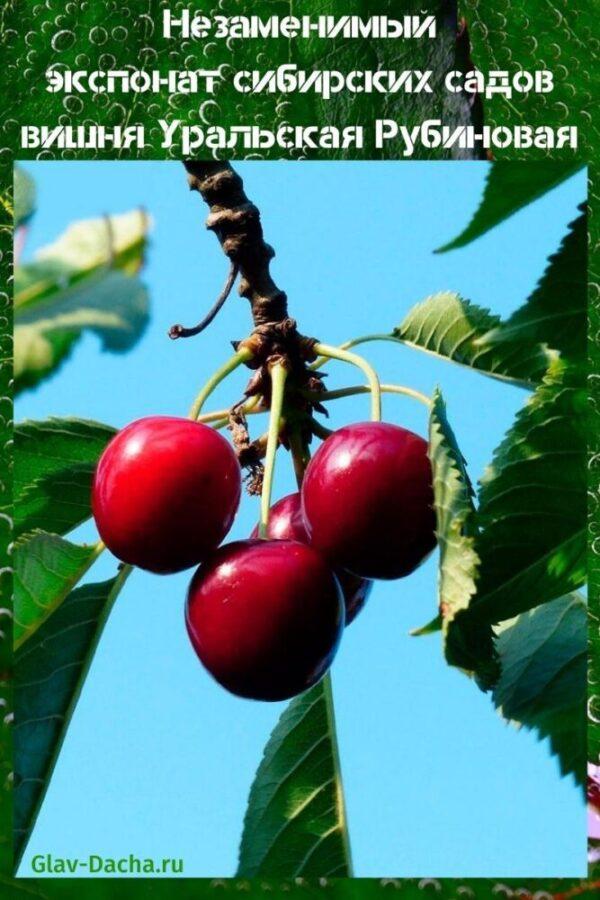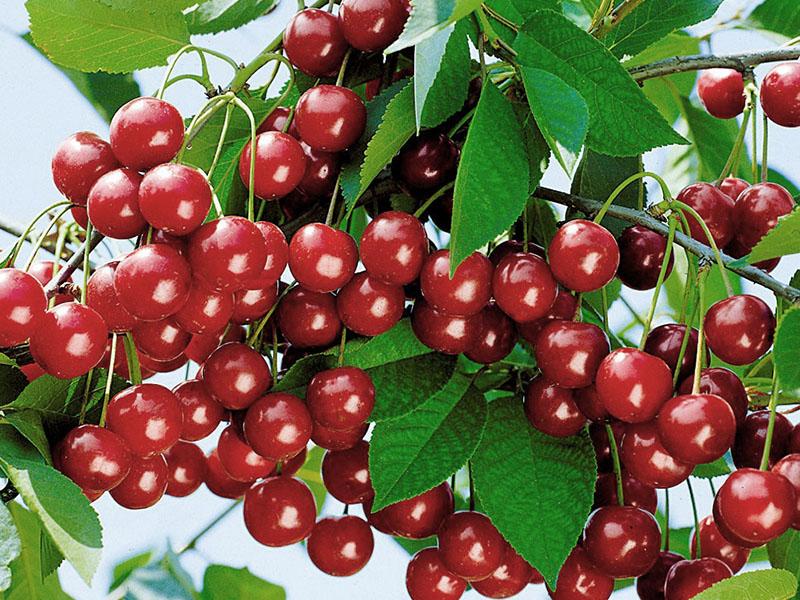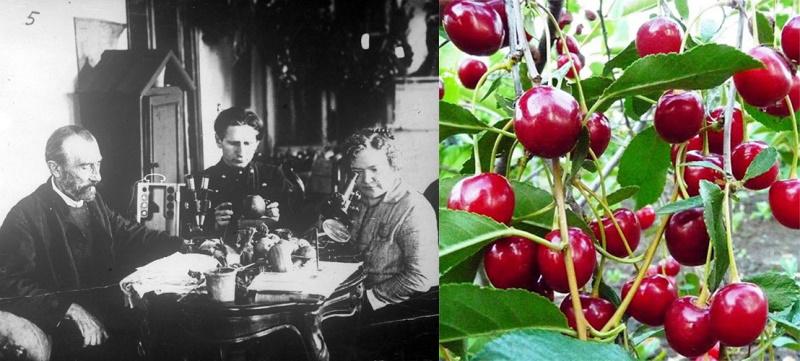Irreplaceable exhibit of Siberian gardens Uralskaya Rubinovaya cherry
 Cherry Ural Ruby is valued for its high yield, short stature, and resistance to drought and frost. Ripening of large fruits is observed in the third decade of August. The variety is ideal for growing in the northern regions, as well as in the Urals and Siberia. Due to its unpretentiousness, the culture is able to survive even in adverse conditions. In addition, for breeders, the hybrid serves as an excellent pollinator used to create high-yielding varieties.
Cherry Ural Ruby is valued for its high yield, short stature, and resistance to drought and frost. Ripening of large fruits is observed in the third decade of August. The variety is ideal for growing in the northern regions, as well as in the Urals and Siberia. Due to its unpretentiousness, the culture is able to survive even in adverse conditions. In addition, for breeders, the hybrid serves as an excellent pollinator used to create high-yielding varieties.
Back to the past


As a result of such a scientific experiment, a hybrid was obtained, which was zoned for such regions of Russia as:
- Ural;
- Vyatsky;
- West Siberian.
Today this variety is successfully grown in the Perm, Sverdlovsk and Chelyabinsk regions. It was entered in the State Register in 1959 and is still used as the main crop for creating productive and winter-hardy hybrid varieties.
Description in detail
 The crop is a small shrub, not a tree. It usually reaches a height of 1.5 m, and under favorable conditions it grows up to 1.8-2 m. It forms an unusually wide spherical crown, slightly flattened at the top. It is formed by spreading and slightly drooping branches, thanks to which the bush has an average degree of thickening.
The crop is a small shrub, not a tree. It usually reaches a height of 1.5 m, and under favorable conditions it grows up to 1.8-2 m. It forms an unusually wide spherical crown, slightly flattened at the top. It is formed by spreading and slightly drooping branches, thanks to which the bush has an average degree of thickening.
The description of the cherry variety Uralskaya Rubinova also includes the characteristic:
- Shoots. Young stems are colored dirty green. Over time, they acquire a brown-brown color.
- Leaves. Plates are broadly lanceolate leathery with a pointed apex and a serrated edge. Outwardly they resemble a miniature boat. The upper part of the foliage is presented in dark green color with a spectacular glossy sheen, and the lower part is light with a bluish undertone.
- Flowering. They form on annual shoots (sometimes on short branches of inflorescences) in the form of bouquet bunches. Each of them has up to 10 flower buds.
- Fruits. Berries of a rounded shape of a rich ruby shade with juicy and fleshy pulp of the same color. The weight of ripe fruits is small: 3.5-4 g, and the diameter is 15-17 mm. The taste is sweet and sour with a pleasant cherry aftertaste.
The fruits are highly resistant to cracking. The stone separates perfectly from the pulp, which makes cleaning the crop easier. The berries are firmly adhered to the stalks, therefore they do not crumble until fully ripe.
 Many gardeners are interested in the question of when cherry blossoms in the Urals. Since the variety was created exclusively for a cool climate, the budding period falls on the end of May or the beginning of June. Due to this, the risk of damage to the ovaries by late frosts is minimized. Fruiting of a shrub plant is observed closer to mid-August.
Many gardeners are interested in the question of when cherry blossoms in the Urals. Since the variety was created exclusively for a cool climate, the budding period falls on the end of May or the beginning of June. Due to this, the risk of damage to the ovaries by late frosts is minimized. Fruiting of a shrub plant is observed closer to mid-August.
Characteristics
 Due to the specific structure of the flowers, the cherry variety of the Ural Rubinova is not capable of self-pollination.
Due to the specific structure of the flowers, the cherry variety of the Ural Rubinova is not capable of self-pollination.
For this reason, additional external pollinators are planted near the crop at a distance of 1-2 meters - self-fertile varieties:
- Lighthouse;
- Vole;
- Zagrebinskaya;
- Ural standard;
- Alatyrskaya;
- Star;
- Generous.
 Of course, other varieties are also chosen. Yet a distinctive feature of each of them should be late flowering. Due to this, the berries on the bush ripen quite amicably, which allows you to harvest the crop in just one step. From one specimen, up to 8-10 kg of fruits are obtained, and from 1 hectare - 60-90 centners (when grown for industrial purposes).
Of course, other varieties are also chosen. Yet a distinctive feature of each of them should be late flowering. Due to this, the berries on the bush ripen quite amicably, which allows you to harvest the crop in just one step. From one specimen, up to 8-10 kg of fruits are obtained, and from 1 hectare - 60-90 centners (when grown for industrial purposes).
Young seedlings begin to bear fruit 2-3 years after planting. The active period of ovary formation lasts for 13-15 years. In the future, the plant brings lower yields over the next 10-15 years.
Cherry Ural Ruby withstands severe Siberian frosts. The buds of the hybrid do not freeze even at -30 ... -35˚С. This feature is due to the low growth of the shrub. In snowy winters, the plant takes cover 2/3 of its height, which serves as a natural protection for it. In addition, the winter-hardy variety perfectly adapts to other abnormal phenomena, for example, to drought.
Nevertheless, he has several dangerous "enemies":
- coccomycosis disease;
- sawfly;
- cherry aphid.
 A fungal infection causes irreparable harm to the plant. Spores often progress in a humid, warm environment. In May-June, red-brown spots appear on the leaves. As the disease progresses, these spots merge into a single whole. On the back of the deciduous plate, gray-white tubercles are formed, in which there are fungal spores. Towards the end of summer, the foliage turns yellow, curls and falls off.
A fungal infection causes irreparable harm to the plant. Spores often progress in a humid, warm environment. In May-June, red-brown spots appear on the leaves. As the disease progresses, these spots merge into a single whole. On the back of the deciduous plate, gray-white tubercles are formed, in which there are fungal spores. Towards the end of summer, the foliage turns yellow, curls and falls off.
Coccomycosis treatment methods. Spraying the bush and the trunk circle is carried out during the swelling of the buds. For this, copper-containing fungicides are used: copper oxychloride (40 g / 10 l), bordeaux liquid or the drug Abiga-Peak (50 ml / 10 l).
Cherry Ural Ruby is ready for planting
 Early spring is a good time to plant a crop. Saplings are planted before bud break. A well-lit area is chosen from the west or north / south-west side of the garden. It is desirable that it be a slope or a hill. On the plains and in the lowlands, the variety does not take root well and is often sick. In such conditions, there is frequent stagnation of water, as well as a lack of good air circulation. These factors often lead to the death of a culture.
Early spring is a good time to plant a crop. Saplings are planted before bud break. A well-lit area is chosen from the west or north / south-west side of the garden. It is desirable that it be a slope or a hill. On the plains and in the lowlands, the variety does not take root well and is often sick. In such conditions, there is frequent stagnation of water, as well as a lack of good air circulation. These factors often lead to the death of a culture.
The correct soil substrate must be selected:
- fertile;
- with a neutral reaction;
- loose enough;
- with a groundwater bed of at least 2 m.
 Light loamy soil types will be an ideal option for planting and caring for Ural cherries. The agrotechnology of planting a young shrub has some subtleties. For good growth of shoots, it is recommended to maintain a distance of 2 meters between seedlings. The size of the planting hole remains standard: both the depth and the diameter are about 50-60 cm. Such dimensions are necessary for the rhizome to freely enter the hole.
Light loamy soil types will be an ideal option for planting and caring for Ural cherries. The agrotechnology of planting a young shrub has some subtleties. For good growth of shoots, it is recommended to maintain a distance of 2 meters between seedlings. The size of the planting hole remains standard: both the depth and the diameter are about 50-60 cm. Such dimensions are necessary for the rhizome to freely enter the hole.
Into the landing hole:
- humus (bucket);
- superphosphate (up to 40 g);
- potassium chloride (20 g);
- wood ash.
If the soil is clay, then sand (bucket) must be added. Too acidic soils are additionally treated with lime or dolomite flour.
 A seedling, the roots of which have been soaked for 3 hours in warm water, is lowered into the hole. The rhizome is sprinkled with fertile soil and slightly compacted. The basal neck does not deepen, it is located flush with the ground. At the end, the site is thoroughly watered with settled water (2-3 buckets). The soil is mulched with a dense layer of hay, humus, compost or deciduous litter.
A seedling, the roots of which have been soaked for 3 hours in warm water, is lowered into the hole. The rhizome is sprinkled with fertile soil and slightly compacted. The basal neck does not deepen, it is located flush with the ground. At the end, the site is thoroughly watered with settled water (2-3 buckets). The soil is mulched with a dense layer of hay, humus, compost or deciduous litter.
Simple care technology
 At first, constant care is organized for the seedling. In dry weather, the bush is watered. This procedure should not be too frequent in order to avoid root rot. Loosening of the soil is also systematically carried out. Together with this, the mulch layer is renewed. Seasonal pruning is planned for spring and autumn.
At first, constant care is organized for the seedling. In dry weather, the bush is watered. This procedure should not be too frequent in order to avoid root rot. Loosening of the soil is also systematically carried out. Together with this, the mulch layer is renewed. Seasonal pruning is planned for spring and autumn.
The following branches are removed:
- dry;
- damaged;
- sick;
- improperly growing.
To make the Ural Rubinovaya cherry feel great in a new place, regular feeding is carried out. In the fall, phosphorus and potash complexes are introduced for digging. Every 3 years the site is fertilized with rotted manure or compost. Nitrogen compounds are used in the spring. Such a technology for caring for a hardy variety will bring the gardener a rich and high-quality harvest.
Cherry Ural Ruby for your garden - video
https://www.youtube.com/watch?v=iH8QBn1_rTY